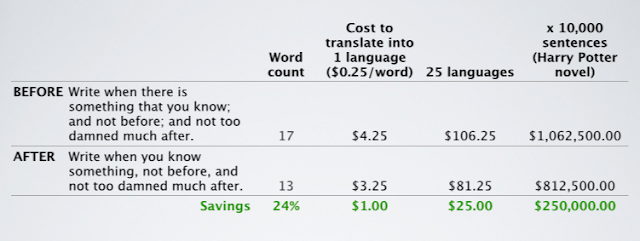by Marcia Riefer Johnson, Science and Technology Division Distinguished Speaker at the 2015 American Translators Association Annual Conference
Why I Talk about Tight Writing
We all use too many words. In and of itself, cutting unhelpful words (or sentences, or paragraphs, or whole chapters or blog posts) doesn’t make writing good. But it always makes writing better.
One reason to care about conciseness is money. Extra words carry dollar signs—especially if your company publishes in multiple languages. If you tighten before you translate, you can save staggering amounts of money.
As Val Swisher, author of Global Content Strategy: A Primer, says, when you tighten your sentences, you achieve “the ultimate trifecta: cheaper, better, faster translations.”
The “cheaper” part of that trifecta comes down to simple math. This spreadsheet example shows how I tightened a sentence from the book Death in the Afternoon, written by Mr. Minimalism himself, Ernest Hemingway. His sentence has 17 words: “Write when there is something that you know; and not before; and not too damned much after.” Remove four words, and you increase the sentence’s impact without losing any meaning or sacrificing sonorousness. More impressively, at least from a business point of view, this kind of edit reduces translation cost. At 25 cents per word per language (a common translation rate), cutting these four words reduces the cost of translating this sentence into 25 languages by $25.
Not impressed? Scale up to 10,000 sentences. (That’s how many you’ll find in a typical Harry Potter novel. Many websites contain far more.) Reduce each sentence’s word count by this same percentage, and you save $250,000.
If your company delivers lots of translated content and tightens its text by even ten percent, it can save millions—or tens of millions or hundreds of millions—every year.
Whether you’re a writer or a strategist who works with writers, imagine the raise you’ll justify when you routinely save your employer or clients this kind of money.
Download:
But Money Isn’t Everything
Even if you don’t care what it costs to produce and maintain unnecessary words, you care about losing readers. Concise means readable. Concise means comprehensible. Concise means efficient. No reader—no customer—abides bloat. In any language.
When you lose readers, when you lose customers, you lose.
My Favorite Tightening Technique
Want to know my favorite tightening technique? Dump these words—unless you need them. That’s it. Simple and surprisingly powerful. (If you’ve seen my “WriteTight(er)” presentation, you’ll recognize this as my “Dump These Words” list.)
- weak be-verbs (is, was, were, will be, have been, am, are)
- –lywords (& other vapid adverbs)
- very, such, so (& other empty intensifiers)
- not, no (& other negative words)
- the fact that
- just
- begin to, try to, tend to, in order to
- period of time
- in light of, in spite of, in terms of(& of in general)
- proverbial
- different (as in many different, 36 different)
- particular
- verbiage
- any other verbiage*
or unneeded words that you can pitch
*Verbiage includes redundancies of all kinds. See “The Annals of Redundancy Annals.”
Don’t Let It Be
You may have noticed that I bolded the top bullet in the list above. If you do nothing else, eradicate most be-verbs, and you dramatically tighten and strengthen any English text. I’ve developed a number of resources on this one tip—see my page “Be and Me.”
Don’t miss the Be-Verb Song, sung with panache by Benjamin Kjos!
Let’s Play a Game!
Every week, I post a “Tighten This!” Challenge Question—and announce the previous week’s winners. Want to play? Want a shot of fun while building your concise-writing skills with word-loving friends? Want to edify your inner editor? Subscribe to my blog under the heading “Sign Up!” (above right or, on a mobile device, all the way at the bottom). Then, each time I publish a post, you’ll receive an email.


